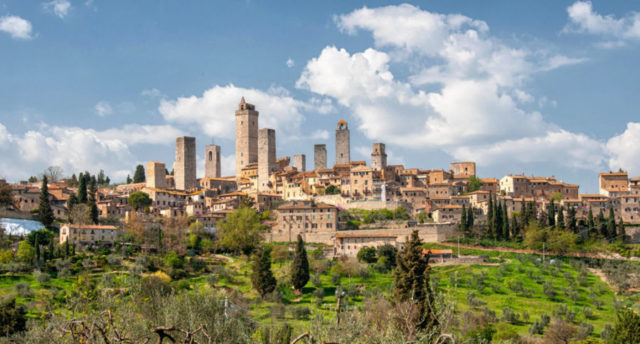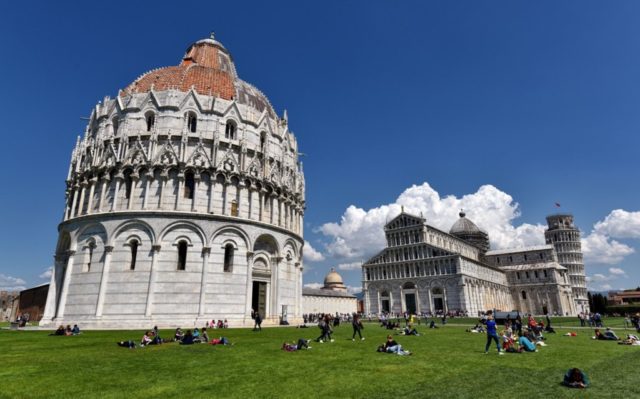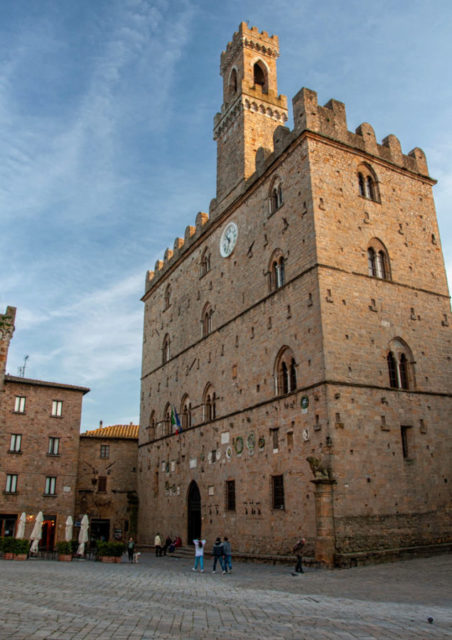Exploring the tiny, hill-capping town of Montepulciano, I wandered up a side-street from the main square. Looking back, I was struck at how the facade and tower of the town hall — so stately and respectable from the middle of the square — were clearly pasted onto a rough brick structure. This reminded me that Tuscany is obsessed with its fancy towers.

“Italy” as we know it was an invention of the 19th century. During Tuscany’s medieval and Renaissance prime, this region was a collection of feuding city-states dominated by rich families. To this day, Tuscans remain fiercely loyal to their home community, and are keenly aware of subtle differences between people from different cities, towns, and villages. (Italians have a wonderful word for this: campanilismo, meaning that a community consists of the people within earshot of its bell tower — campanile.)

One of Tuscany’s architectural fortes are its fortified townhouses. Many towns have several such tower houses — representing the many, often competing wealthy families who once lived there. San Gimignano famously has 14. In those Romeo and Juliet days of feuding families, prickly skylines like San Gimignano’s were commonplace.

Some of these townhouses still have an intact tower — the keep, or place of last resort for a noble family. But many others have had the tower lopped off. If you know what to look for, it’s often possible to see the faint outlines of a former tower embedded into the side of an otherwise nondescript townhouse.

This Tuscan territoriality — even within a single town — can be taken to extremes. On my visit to Montepulciano earlier this summer, I noticed various colorful flags that flew in different parts of town. A local explained that these represent the eight different contrade (neighborhoods) within this small town of just 14,000 people: the red-and-black castle of Voltaia, the blue-and-white flag of Poggiolo, the green-black-and-yellow lion of Gracciano, and so on. Tensions run high between rival contrade, and everyone comes together the last Sunday in August, when the strongest young lads from each contrada compete to see who can roll a 180-pound wine barrel all the way up the steep main drag. (The ultimate expression of this is Siena’s famous Palio horse race — which is, at its basest level, a pissing match between contrade.)
The most famous Tuscan tower, of course, is the tipsy one in the city of Pisa. While the Leaning Tower of Pisa is a touristic cliche, the surrounding Field of Miracles is well worth a visit.

The “Leaning Tower” is simply a bell tower for Pisa’s grand 12th-century cathedral, which mixed Romanesque, Byzantine, and Gothic architectural elements in an eye-pleasing melange called “Pisan Romanesque.” And the cathedral and tower are just two parts of a striking ensemble of white-marble buildings that share an unusual architectural harmony, all connected by a putting-green-quality lawn.

While tourists pose for goofy “holding up the tower” photos, travelers who do a little homework appreciate how these buildings — baptistery, cathedral, hospital, cemetery — symbolically follow the human life span, from birth to marriage to illness to death. (To be entirely clear, it’s perfectly fine to also snap one of those goofy photos. Hey…you’re on vacation.)
In many towns, the tallest tower belongs not to a rich family’s mansion, or even to the church, but to the town hall. Like Scandinavia today, Renaissance Tuscany placed tremendous faith in the role of a well-run state. In fact, Siena’s City Hall — one of the region’s biggest and best — is decorated with frescoes illustrating the consequences of both good and bad government.

Religious as Tuscans were (and remain), they were also humanistic — with a deep, abiding belief in the importance of humanity. While the medieval worldview dictated that the realm of God, Jesus, and the saints was the one and only thing that mattered, Renaissance Humanists began to recognize that the deeds of humans on earth were also significant. In fact, the greatest deeds of humans were seen as the ultimate expression of God’s power.

The right hand of Michelangelo’s David is hyper-detailed and over-developed. In a sense, it’s the hand of God. Michelangelo’s message: The humble shepherd boy David succeeds in slaying the giant Goliath not just because he’s a powerful man, but also because he is super-charged with the will of God. When Michelangelo created a statue, he believed he was chipping away a form that already existed within the stone (put there by God). And when he painted the Sistine Chapel ceiling at the Vatican, it was a great expression of faith in both God and humanity. (The billowing clouds surrounding the famous scene of God giving Adam the spark of life is, not coincidentally, shaped like a human brain.) This harmony between God and humanity is the essence of the Tuscan Renaissance.

And so, when you see the towers of Tuscany, look at them as giant versions of David‘s hand. Tuscan towers are exclamation points — proclaiming the worthiness of humanity overcoming a thousand years of darkness, fear, and brutality. They are a statement that together, and backed by God, humanity can accomplish great things.
Heading to Tuscany? I share a dozen of my favorite Tuscan experiences here.
Our new Best of Tuscany in 12 Days Tour — which begins in 2020 — incorporates many vivid experiences in Italy’s heartland…including visits to many places mentioned here, including a day in Siena, with one of Tuscany’s most striking towers.
Or, to do it on your own, you’ll find all of the details you need in our Rick Steves Florence & Tuscany guidebook.